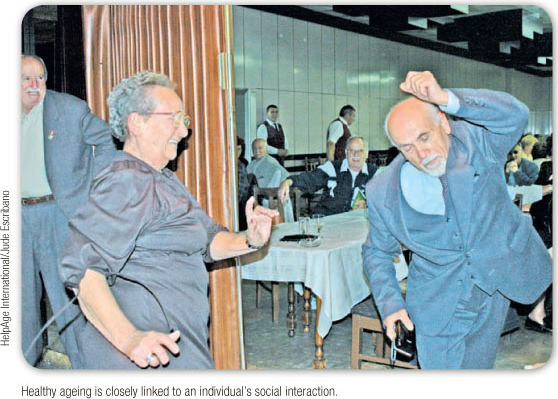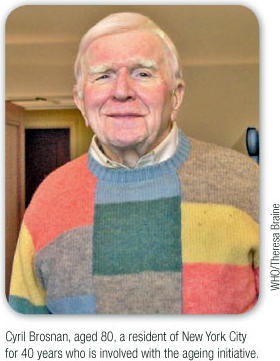NEWS
Network of cities tackles age-old problems
Jane Parry investigates how cities around the world are catering for the explosive growth in the number of people aged over 60.
The world's population of people aged over 60 will double from 11% in 2006 to 22% by 2050. Even more dramatic will be the growth in the number of the very old. Between 1950 and 2050, the number of people over the age of 80 will grow from 14 million to 400 million worldwide. At the same time, the pace of urbanization continues unabated: by 2030 an estimated three in five people will be urban dwellers.
"All levels of government are starting to realize how important the demographic transition is," says John Beard, director of the Department of Ageing and Life Course at the World Health Organization (WHO) in Geneva. "People have been struggling for a number of years in knowing how to respond. WHO's Age-friendly Cities programme gives them something tangible as a way to address these trends."
The programme encourages leaders in cities as diverse as New York and Nairobi to think constructively about how to improve life for older people, a process that has the potential to enhance city life for everyone. To this end, in 2006, representatives from 33 cities in 22 countries met and examined eight areas where cities might influence healthy ageing: outdoor spaces and buildings, transportation, housing, social participation, respect and social inclusion, civic participation and employment, communication and information, and community support and health services.

Following the meeting, a guide and checklist were produced for cities to use to assess their "age friendliness". "Involving older people in assessing age-friendliness and identifying measurable indicators to demonstrate progress ensures it's not just a feel-good exercise," says Beard.
The next step was the establishment of the Global Network of Age-friendly Cities, which connects participating cities from around the world. The network gives member cities access to technical support and training from WHO, as well as the opportunity to share information and experiences.
When a city joins the network, it commits to an initial five-year programme. In the first phase it needs to establish mechanisms that involve older people; conduct an assessment of the city's age-friendliness; develop an action plan and measures that will show if it is making a difference. It then has three years to implement its plan and demonstrate its progress. If the city wishes to stay in the network, it must show continuous improvement through cycles of implementation and evaluation.
A distinguishing feature of the network's approach is the way that it extends far beyond the traditional health sector. "We see healthy ageing as being inextricably linked to an individual's social context, rather than social context being just a factor that affects health," says Beard. "Remaining socially engaged is just as important a component of an older person's health as the absence of diabetes."
"We're hoping to get information through the network on what cities have learnt, what are best practices, what challenges they faced and whether or not they found solutions," explains Simone Powell from WHO's Department of Ageing and Life Course. "Cities can serve as role models and show that some of the achievements may not cost a lot." Unsurprisingly, many measures that make a city age-friendly also make it friendlier for other groups; outdoor seating, accessible public toilets and pedestrian crossings timed with slow walkers in mind also benefit pregnant women, carers of small children and people with disabilities.
The programme team has been contacted by many additional cities that are now initiating age-friendly city projects, such as Donostia-San Sebastian in Spain and Berne in Switzerland. In other countries, national initiatives are emerging. France, for example, has 30 cities signed up to its National Programme on Ageing. The concept has taken off in Canada and Ireland and WHO is also talking to China's National Committee on Ageing about a scheme that might help more than 400 million Chinese citizens who will be aged over 60 by 2050. Pilot studies are being conducted at six locations in China.
Other cities have progressed even further. In New York, for example, the city council and the mayor's office formed a partnership with The New York Academy of Medicine to consult with the city's seniors, service providers, advocates and experts. A key outcome was to convene a high-level commission to ensure that the recommendations are implemented over the next four years. Already in progress are 59 public-sector initiatives to improve the lives of older New Yorkers, such as using school buses during off-peak hours for transport to nearby supermarkets.
Public-private partnerships are also key to this programme. The Commission for an Age-friendly New York City includes business leaders and philanthropists as well as municipal and health service officials, explains Ruth Finkelstein, vice-president for health policy at The New York Academy of Medicine and a spokesperson for the ageing initiative.
"We conducted 15 community meetings and a number of focus groups in immigrant communities [that] helped to focus the attention of policy-makers, civic leaders and service providers on how to make the whole city age-friendly."
Some of the changes identified by the focus groups are surprisingly simple, such as making library personnel available to advise older adults on using the Internet. Maintaining sidewalks is another example of small changes having a big impact. "People want to feel comfortable here. They don't want to be worried about manholes and sidewalks. They want to be able to sit down once in a while and rest," says Cyril Brosnan, aged 80, a resident of New York City for 40 years, who is involved with the ageing initiative.

"The simple steps of having everybody sweep their sidewalks, keeping them cleared of snow and leaves, really enforcing the pick-up-after-your-pets rules, and keeping a clear pathway, as well as repairing bumps and holes and metal sticking up out of the sidewalk, are critical for older adults walking around the city," says Finkelstein.
The importance of age-friendly outdoor spaces was echoed by Yilmaz Bas, a 71-year-old resident of Istanbul. "I have to tell you about the social recreation areas all around Istanbul. You can go with your family whenever you want and rest and eat or drink something for a very cheap price," he said. "All the toilets and the sitting areas are specially designed for disabled people so you feel comfortable. They are very important to make older people active in life."
Istanbul's participation in WHO's Age-friendly Cities Programme has brought a range of measures to improve life for the elderly. The findings of the initial focus-groups were shared with related organizations, and the municipal government hosted an international good-practices meeting providing the opportunity to learn from other cities. This meeting heralded many changes in Istanbul to take the needs of older people into account: from free public transport to improved disabled access to public buildings and improved health services. A Council for Older People is also being set up.

"It was terrible to go from one place to another in Istanbul three years ago," said Bas. "But now, there are lots of alternatives and they are comfortable and safe."
"Istanbul has a young population. The needs of older people were not on the agenda, and it was known that it wouldn't be easy to become an age-friendly city all at once," says Aylin Çiftçi, director of the health department of Istanbul Metropolitan Municipality. "All these services play an important role in making older people active in life. They feel more comfortable and safe," says Çiftçi. "It is also good for their families. All these facilities help society reduce the generation gap between the elderly and the others."
It is this closing of the generation gap that Beard thinks might prove to be one of the greatest legacies of WHO's age-friendly city initiative. "What we have tended to do in public health is to isolate people into target groups. It may have been well-meaning, but we now talk and think about maternal health, child health, old people's health," he says. "This artificial compartmentalization marginalizes older people. By making us think about how we all link to each other, regardless of our age, age-friendly cities show us a different, more connected, future."
